Related Research Articles

Alexander Young Jackson LL. D. was a Canadian painter and a founding member of the Group of Seven. Jackson made a significant contribution to the development of art in Canada, and was instrumental in bringing together the artists of Montreal and Toronto. In addition to his work with the Group of Seven, his long career included serving as a war artist during World War I (1917–19) and teaching at the Banff School of Fine Arts, from 1943 to 1949. In his later years he was artist-in-residence at the McMichael Canadian Art Collection in Kleinburg, Ontario.

Frederick Horsman Varley was a member of the Canadian Group of Seven.
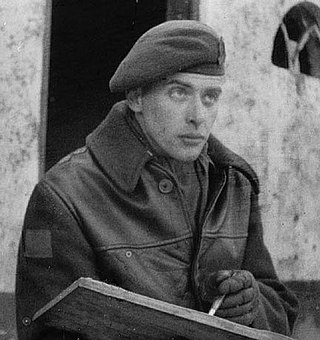
David Alexander Colville, LL. D. was a Canadian painter and printmaker who continues to achieve both popular and critical success.
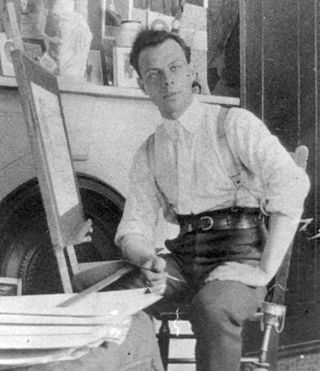
David Milne was a Canadian painter, printmaker, and writer. He was profoundly different from most of his Canadian art contemporaries, especially Tom Thomson and the Group of Seven.

Florence Helena McGillivray, also known as F H. McGillivray, was a Canadian landscape painter known for her Post-Impressionist style. Her family home was in Whitby, Ontario. She lived in Ottawa from 1914 to 1928. She was also a teacher. In 1916, on a visit to his studio, she encouraged Tom Thomson.

Annie Pootoogook was a Canadian Inuk artist known for her pen and coloured pencil drawings. In her art, Pootoogook often portrayed the experiences of those in her community of Kinngait, in northern Canada, and memories and events from her own life.

Pegi Nicol MacLeod,, was a Canadian painter whose modernist self-portraits, figure studies, paintings of children, still lifes and landscapes are characterized by a fluidity of form and vibrant colour. Born Margaret Kathleen Nichol, she was a teacher, war artist and arts activist. In 1936 she became a member of the Canadian Society of Painters in Water Colour and one year later she joined the Canadian Group of Painters.
Alma Mary Duncan was a Canadian painter, graphic artist, and filmmaker from Paris, Ontario. A prolific artist working in a variety of mediums including charcoal, chalk pastel, ink, watercolour, oil paint, puppetry, and film, Duncan's style evolved drastically over the course of her career to include portraiture, precise representational drawings, machine aesthetic, and abstraction.

Isabel McLaughlin, was a Modernist Canadian painter, patron and philanthropist. She specialized in landscapes and still life and had a strong interest in design.
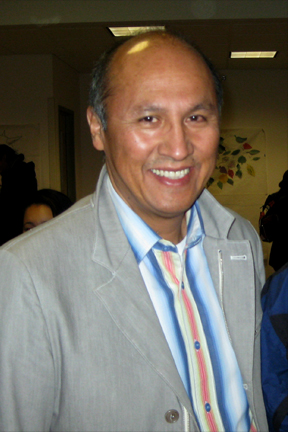
Gerald Raymond McMaster is a curator, artist, and author and a Plains Cree member of the Siksika Nation. McMaster is a professor at OCAD University and is the adjunct curator at the Remai Modern in Saskatoon, Saskatchewan.
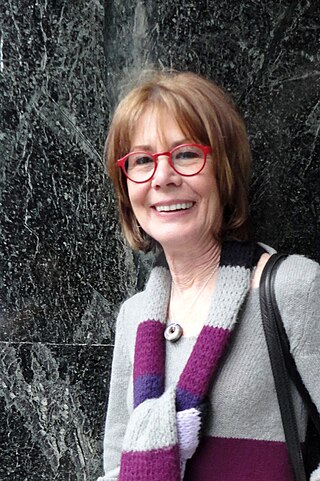
Suzy Lake is an American-Canadian artist based in Toronto, Canada, who is known for her work as a photographer, performance artist and video producer. Using a range of media, Lake explores topics including identity, beauty, gender and aging. She is regarded as a pioneering feminist artist and a staunch political activist.
Ingo D. W. Hessel is a Canadian art historian and curator specializing in Inuit Art. The author of Inuit Art: An Introduction, Hessel has curated exhibitions for the Heard Museum in Phoenix, Arizona, the Museum of Inuit Art in Toronto, and the Art Gallery of Ontario in Toronto.
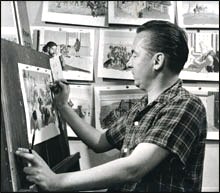
Jean-Philippe Dallaire was one of the leading artists working figuratively in the 1960s in Canada. He is known for his festive scenes peopled by macabre characters.
Carol Wainio is a Canadian painter. Her work, known for its visual complexity and monochrome color palette, has been exhibited in major art galleries in Canada, the U.S., Europe and China. She has won multiple awards, including the Governor General's Award in Visual and Media Arts.

Franklin Brownell born in New Bedford, Massachusetts was a landscape painter, draughtsman and teacher active in Canada. He artistic career in Ottawa spanned over fifty years.

Mary Evelyn Wrinch (1877–1969), was a Canadian artist who created miniature paintings, oil paintings, and block prints, sometimes inspired by the Northern Ontario landscape. She pioneered the 'Canadian style', painting landscapes with bold colours of the Algoma, Muskoka and Lake Superior regions, in situ. In her miniature paintings on ivory, she depicted her sitters with freshness and vitality. Her colour block prints are virtuoso examples of the medium.
Meryl McMaster is a Canadian and Plains Cree photographer whose best-known work explores her Indigenous heritage. Based in Ottawa, McMaster frequently practices self-portraiture and portraiture to explore themes of First Nations peoples and cultural identity, and incorporates elements of performance and installation to preserve her mixed heritage and sites of cultural history in the Canadian landscape.
Barry Ace (artist) (born 1958) is an Anishinaabe (Odawa) photographic and multimedia artist and curator from Sudbury, Ontario. Ace's work includes mixed media paintings, and mixed media textile and sculptural work that combines traditional Anishinaabe textiles and beadwork with found electrical components. Ace has a strong interest in combining traditional and contemporary technologies, aesthetics, and techniques in his artwork.

Jinny Yu is a Canadian artist working primarily in the fields of painting and installation art.
Alicia Boutilier has been the Curator of Canadian Historical Art at the Agnes Etherington Art Centre since 2008 and in addition, was appointed Chief Curator in 2017. In 2020, she served as the Interim Director at the gallery and received a special recognition award from Queen's University at Kingston for her work as a team leader, adapting to the new realities caused by Covid. She is a Canadian art historian with wide-ranging concerns, among them women artists, the building of collections, and the combination of art with craft.
References
- ↑ McMann, Evelyn de Rostaing (January 2003). Leslie Mary Margaret Reid. University of Toronto Press. ISBN 9780802027900 . Retrieved 21 December 2019.
- ↑ Burant, Jim (2022). Ottawa Art & Artists: An Illustrated History. Toronto: Art Canada Institute. ISBN 978-1-4871-0289-0.
- ↑ Heller, Jules; Heller, Nancy G. (2013). North American Women Artists of the Twentieth Century. Routledge. p. 465. ISBN 9781135638825 . Retrieved 2021-07-26.
- 1 2 3 4 5 6 7 8 9 10 11 12 13 14 15 "Leslie Reid". bonavistabiennale.com. Bonavista Biennale. Retrieved 2021-07-26.
- 1 2 3 4 5 "Leslie Reid". arts.uottawa.ca. University of Ottawa. Retrieved 2021-07-28.
- ↑ "Three Artists from Los Angeles". www.tate.org.uk. Tate Gallery, London, UK. Retrieved 2021-08-09.
- 1 2 3 4 Nemiroff, Diana (2013). Light as Metaphor. Leslie Reid: A Darkening Vision. Ottawa: Carleton University Art Gallery. Retrieved 2021-08-03.
- 1 2 3 4 Jonathan Shaughnessy, Acquisition Proposal for Leslie Reid’s Cape Pine: The Road and Cape Pine: The Cairn, accession #45406 and #45407, Curatorial File, National Gallery of Canada.
- 1 2 3 4 5 6 7 8 9 A Dictionary of Canadian Artists, volumes 1-8 by Colin S. MacDonald, and volume 9 (online only), by Anne Newlands and Judith Parker National Gallery of Canada / Musée des beaux-arts du Canada
- 1 2 3 4 5 "Collection". www.gallery.ca. National Gallery of Canada. Retrieved 2021-08-07.
- ↑ Burant, Jim (2022). Ottawa Art & Artists: An Illustrated History. Toronto: Art Canada Institute. ISBN 978-1-4871-0289-0.
- ↑ Joan Murray, "Making a Fresh New Thing: Ten Painters". artmagazine 43/44 (1969-1979), p. 24, 1970
- 1 2 3 Gessell, Paul. "PROFILES: Arctic inspires new art by Leslie Reid". ottawamagazine.com. Ottawa Magazine, Winter 2014. Retrieved 2021-08-09.
- ↑ Nancy Baele, "Slate, chalk, lead – it must be November". Ottawa Citizen, 22 Nov 1990
- ↑ Burant, Jim (2022). Ottawa Art & Artists: An Illustrated History. Toronto: Art Canada Institute. ISBN 978-1-4871-0289-0.
- ↑ Rynor, Becky. "An Interview with Leslie Reid". www.gallery.ca. Magazine, National Gallery of Canada. Retrieved 2021-08-06.
- ↑ Valerie Knowles, Young artist's coup – all 30 feet of it. Ottawa Journal, December 1978
- ↑ Anderson, Heather (2012). "Review". Canadian Art (Spring). Retrieved 2021-08-08.
- ↑ Sandals, Leah. "Canadian Biennial Aims to Build Different Vision of National Art". canadianart.ca. Canadian Art Online Posted 2012. Retrieved 2021-08-09.
- 1 2 "Mapping the North". www.gallerieswest.ca. Galleries West Magazine, 2016. 8 January 2016. Retrieved 2021-07-27.
- ↑ "Leslie Reid Visual Artist". canadac3.ca. Canada C3. Retrieved 2021-08-09.
- 1 2 "ᓯᑯ ᕿᕐᓂᖅᓯᓯᒪᔪᖅ DARK ICE". oaggao.ca. Ottawa Art Gallery. 20 May 2022. Retrieved 9 February 2023.
- ↑ Babinska, Anna (1990). Leslie Reid : Landscape into Light, Paintings and Prints, 1974-1990. ISBN 9781895108026 . Retrieved 2021-08-03.
{{cite book}}:|website=ignored (help) - ↑ Dyck, Sandra. "Surfacing". e-artexte.ca. Carleton U Art Gallery, Ottawa. Retrieved 2021-08-06.
- ↑ Nancy Baele, Adding photographs, painter questions herself more deeply. Ottawa Citizen, August 11, 1996
- ↑ "Collection". ago.ca. Art Gallery of Ontario. Retrieved 18 January 2022.
- ↑ "Afterimage: Making Art and Mothering Teens". jarm.journals.yorku.ca. Journal of the Association for Research on Mothering Vol 5, No 1 (2003),pp. 111-118. Retrieved 2021-08-08.